August Golf Diary
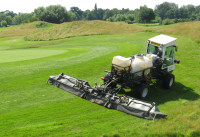
For many clubs, August is generally quieter since it is the key holiday month of the year and a time when many staff also choose to take their annual vacation. As a result, society and competition play tends to be low key, although there are always exceptions.
Growth will be fairly light, since soil conditions are generally dry and day time temperatures are similar to those in July. Only towards the end of August is there a noticeable change in reduced daylight hours and the start of damper mornings.
Most Augusts of late have generally been dry and warm although the last 2 years have been the opposite. Therefore, the key issues this month are the avoidance of turf stress and to focus on reducing the risk of any late summer disease. If weather conditions remain unsettled and there is sufficient moisture in the ground, then course presentation should remain very good.
Rainfall in August tends to be adequate although more often than not it does fall in short heavy bursts.
Greens
Maintenance requirements on golf greens in August will be very similar to that in July since much the same conditions apply; i.e. high temperatures, long hours of daylight and possibly limited rainfall. Added to the fact that staffing levels may be lower due to holidays, there may be a need to focus on priorities.
This essentially means retaining sufficient moisture levels in the soil/root-zone and limiting the risk of turf stress. As per last month, the key aspects are to reduce the frequency of any grooming or verti-cutting and replacing this with brushing.
Monitor mowing heights on a daily basis and raise by 0.5mm if the turf shows signs of weakness. Consider rolling as opposed to mowing but limit this to twice per week. Ensure that sufficient water is applied, but only for the benefit of the turf. Ideally, this should be via hand watering but staffing levels may not be sufficient for this to be practical for any length of time. Sarel rolling, micro, star or needle tining should be at the forefront of any work practices, thus ensuring that both wetting agent and water is able to move through the surface quickly and target the areas as required.
Where dry patch or drought stress is confined to ridges or high 'shoulders' then consider applying a granular wetting agent following mini-coring to these areas. This must be thoroughly watered in for it to be effective in breaking down the waxy organic layer that surrounds the sand or soil particles.
Nutrient requirement will largely depend on the needs of the turf. If rain is frequent as per August 2008, then probably additional fertiliser will be required to balance that which has been leached away.
 In hot and dry conditions, the plant partially shuts down and, therefore, has less need for nutrient. However, to help the turf through such periods then it is important to apply a mix of seaweed extracts and humic acids, along with a very small amount of Nitrogen to give the plant sufficient nutrient to restart the photosynthesis process, albeit gradually.
In hot and dry conditions, the plant partially shuts down and, therefore, has less need for nutrient. However, to help the turf through such periods then it is important to apply a mix of seaweed extracts and humic acids, along with a very small amount of Nitrogen to give the plant sufficient nutrient to restart the photosynthesis process, albeit gradually.
Applying a plant growth regulator (PGR) such as Primo Maxx will help divert the plant's energy towards the roots, thus reducing the amount of water that is required as well as improving turf density.
All of the above is, of course, good practice or sound Greenkeeping.
However, many clubs are opting to hollow core greens in August as opposed to April or October. The advantages are that soil conditions are much drier, hours of daylight are much longer and recovery time is considerably less. This work however should be avoided if soil temperatures are high since the turf is put under additional stress and prone to injury. In advance of such treatment, the greens should be lightly fertilised to aid recovery and the rootzone sufficiently watered.
Follow-up top dressing must fill the holes and may require a second but lighter application soon after. Disease risks are also similar to those in July, namely Red Thread, Take all Patch and Anthracnose, although in some instances Dollar Spot can also be witnessed. See comments under the heading 'Watchlist'.
Tees
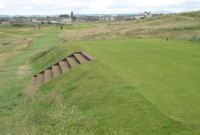 Mowing is unlikely to be more than twice per week unless conditions are wet and growth remains strong. HOC will also remain at around 12mm for most courses but should be raised for non irrigated tees that are suffering from drought stress. Playing levels will remain high, therefore daily movement of tee markers and regular divoting will be the norm to maintain good surface quality and presentation.
Mowing is unlikely to be more than twice per week unless conditions are wet and growth remains strong. HOC will also remain at around 12mm for most courses but should be raised for non irrigated tees that are suffering from drought stress. Playing levels will remain high, therefore daily movement of tee markers and regular divoting will be the norm to maintain good surface quality and presentation.
Any additional watering should be sufficient to aid recovery and maintain turf vigour, but largely aimed at developing a good root structure. Solid tining with no more than 13mm width tines may be an option to help with moving water quickly from the surface. Keeping surfaces clean and free of divots and broken tees must be a daily task as well as the need to clean and maintain all course accessories.
A mid-season feed is likely to have been applied previously but if not then the same scenario applies re a low N, high K feed mixed with a Plant Growth Regulator. Where tees are prone to drought stress then a wetting agent should be applied but the surfaces will need to be watered and lightly tined in advance.
Surrounds
The collars need to be monitored for drought stress, similar to greens but in addition, also for wear since it is on these areas that triplex mowers will be constantly turning. This problem can be exacerbated where hazards are close to the greens surface.
Other than a higher mowing height of around 12mm and usually with a tee triple, the maintenance of the collars should loosely follow that of the greens. High wear areas may need to be tined and dressed and mowing patterns altered to alleviate further damage.
Little work other than mowing at around 35mm will be required on the Surrounds. If water can be applied to key walk-off areas then this should be applied but not at the expense of the greens and collars. A balance of priorities needs to be found.
Fairways
By August, definition between fairway and light rough can often fade due to the lack of growth and dry conditions. Much will depend on the amount of rain that falls unless of course the fairways are irrigated. A foliar application of urea, usually about 1 x 25kg bag per fairway in 600 lts water will give a slight 'green-up' and may give the course some added presentation.
It is a fairly low cost practice although it only lasts for a few weeks. Mowing is likely to be less frequent than in June & July but the HOC will remain the same with most courses cutting at between 14mm and 17mm. At this time of year, divot damage may be slow to recover therefore divoting of the worst affected areas may be required. Any clover remaining on the fairways should be spot treated as per other weeds that may still be present.

Mowing frequency of many areas of rough will be less in August unless it is a wet month and growth is continuing. As before, the main areas of rough are likely to be rotary cut at 50mm. Any areas of intermediate rough will still be cut weekly but this is limited to just one or two 'bands' wide. Cutting areas of deeper rough should continue, with the aim of collecting the grass and lowering the nutrient levels to encourage the finer and slower growing grasses to thrive.
Late summer is also a good time to spray for dock, thistle and other unwanted weed in these out of play areas. If any clover is still prevalent in areas of rough, August is the last month where effective control can be gained. Alkaline and nutrient hungry soils, especially on new courses are particularly prone to clover invasion.
Bunkers
Maintenance during August is largely a continuation of that before with raking being carried out most days, either by hand or via machine. With growth slowing down, any edging and trimming will be slight but the focus needs to remain on stone and weed removal. Regular checks should be made regarding sand depth and distribution.
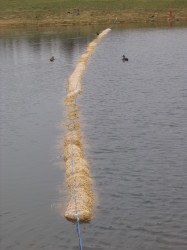 If weed problems persist on sand faces, then these can be spot sprayed with glyphosate but care needs to be taken to avoid any drift onto the surrounding banks. With heavy downpours of rain often being recorded in August, there may be the need for sand to be pushed back up the face if wash-outs occur.
If weed problems persist on sand faces, then these can be spot sprayed with glyphosate but care needs to be taken to avoid any drift onto the surrounding banks. With heavy downpours of rain often being recorded in August, there may be the need for sand to be pushed back up the face if wash-outs occur.
Other
Lakes/Ponds/Ditches: Apart from routine mowing and strimming, the main task is likely to be weed or algae control. The latter can be troublesome at this time of year where there is a lack of air movement and the depth is relatively shallow. If lakes or ponds are not being treated with elongated bales of barley straw then algae can be chemically treated but the application of any aquatic pesticide is best applied by a licensed contractor in order to meet with legislative requirements.
Weeds or bulrushes are often best cleared using a mini-excavator but if the water feature is lined then this will need to be tackled manually which is labour intensive. On larger ponds or lakes, an amphibious craft can be used for weed removal but this is a specialised operation and good advice is strongly recommended.
Paths: The main requirement will be for the on-going control of weeds via an application of glyphosate. This should also be directed to areas of steps and around ball washers, bins, signage etc. Top up pot-holes as required with the appropriate path dressing and consolidate after using a 'whacker' plate or heavy roller.
Watchlist:
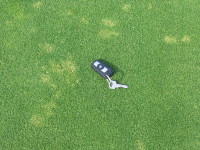 Disease: During August, the main threat of disease is likely to come from Red Thread, Take-All Patch and Anthracnose Foliar Blight plus the possibility of Dollar Spot. Details for prevention and treatment of the former three diseases were listed in previous monthly articles. Anthracnose Foliar Blight is the more common and more damaging disease and is a clear sign of the plant being under stress therefore work practices need to change and the growing environment improved.
Disease: During August, the main threat of disease is likely to come from Red Thread, Take-All Patch and Anthracnose Foliar Blight plus the possibility of Dollar Spot. Details for prevention and treatment of the former three diseases were listed in previous monthly articles. Anthracnose Foliar Blight is the more common and more damaging disease and is a clear sign of the plant being under stress therefore work practices need to change and the growing environment improved.
For more information on how to deal with this disease, then refer to the July diary under 'Greens'. The least common disease that can affect turf in August is Dollar Spot. Although fescue is most at risk, all species can be affected including annual meadow grass. The main causes for Dollar Spot to occur are during periods of short bursts of rainfall with accompanying high temperatures and high levels of humidity.
Prolonged leaf wetness eg dew, low fertility and poor growth are the other factors that favour this disease along with the more common conditions of thatch and compaction. Therefore, the main cultural practices are to reverse the above where possible to limit the risk. Should chemical control be necessary, then apply a product containing Chlorothalonil at the recommended rate.
Pests: Fortunately the risk from any pests during August is fairly low although Crane Fly (Daddy Long Legs) can be in abundance at this time of year as they lay their eggs before their life cycle comes to an end. Each adult can lay up to 300 eggs at the end of summer which take about 2 weeks to hatch. Initial damage usually becomes noticeable in November but best to be aware of initial activity as a sign of action to be taken in 3 months time.
Turf Disorders: Drought stress and dry patch continue to be the main concerns as high soil temperatures can cause stress to the turf. Applying wetting agent must be in conjunction with other practices such as micro-tining, raising the HOC and thoroughly watering the affected areas on a regular basis. Refer to comments listed under 'Greens'.
Weed control: This is the last month where effective control of weeds such as clover can be achieved, although by this time of year, such control should be limited to areas of rough.
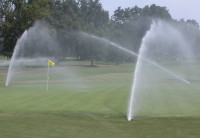 Equipment: Servicing and checking of equipment to continue, with the emphasis still being placed on hydraulic pipes, valves, safety switches and cutting units.
Equipment: Servicing and checking of equipment to continue, with the emphasis still being placed on hydraulic pipes, valves, safety switches and cutting units.
Irrigation: With the system likely to be in constant usage if dry weather continues, regular checks on performance and even coverage are essential, therefore all sprinkler heads and valves need to be checked on a regular basis and any dry or 'missed' areas acted upon immediately to prevent drought stress and eventual dry patch from forming.
The system should also be checked both automatically and manually on a regular basis to ensure maximum performance and coverage.
Compound: With August likely to be a quieter month for mowing, take any opportunity to tidy up external areas of the compound and to check on supplies of sands and gravels which will be required over the coming months.
Laurence Pithie MG
Turf Master One Ltd
www.turfmasterone.co.uk
